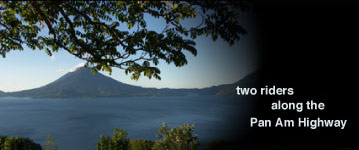
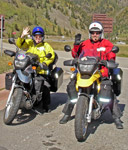
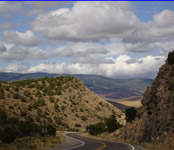
view corresponding gallery | previous entry | next entry
entry 23: chile 06/17/06
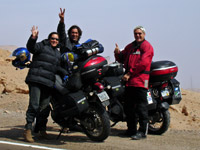 |
| Johnny and Adriana were having a BLAST on their holidays. |
After having traveled through Mexico, all of Central America, Ecuador and Peru, entering Chile felt like we were crossing back into California. The desert was still all around us but the border signs advising visitors of immigration rules and regulations were written in English and Spanish (Spanish is now called Castilian) and the border guards were very helpful. In fact, as we parked our bikes, a female guard came up to us, asked us where we were from, where we were headed and then proceeded to walk our paperwork (and the bike papers) through the entire process for us! No cost to get into the country (it seems that only in Central America do they make ½ of their GNP from border stations), but the customs boys did take a peak into one of our panniers.
The feeling of being back in the states became stronger when we started off down the Pan-American. Cars looked to be in good (drivable) condition, the roads were well marked with city distances and warning signs and the gas stations were top notch. Copec became our gas station of choice due to a chance encounter on our way to the Peru/Chile border. We crossed paths with a couple of great souls on a 660 Yamaha. Johnny and Adriana are from Brazil and were on a four week holiday - touring Chile, Peru and Bolivia. They told us of how cold their Andes crossing had been - and considering that they were wearing only jeans and regular jackets we had no doubt they were chilled to the bone. Despite our native language being English and theirs Portuguese, we managed to share road experiences and trip stories pretty well - in Spanish. They were kind enough to give us a good map which showed Copec gas station locations all over Chili. Finding other riders along the road had become very infrequent (a sure sign winter is arriving to South America), so our short rendezvous with them was especially rewarding. Not trying to sound too much like a commercial for Copec, but I have to say it was a pleasant surprise to have hot coffee, clean restrooms, restaurants that served beef stroganoff for me and for Lynne…hot dogs. After months of eating mostly chicken, Lynne had been craving a good old fashioned hotdog - and she hit the mother-lode of countries for hotdogs. Chile has them at breakfast (in lieu of sausages) and they are sold on nearly every street corner and gas station. For dinner they load them up with fried eggs, potatoes and cheese at a chain restaurant called Doggi’s. The only thing missing now is a Mountain Dew to wash one down with.
Aside from the Copec restaurants, Chile has some very good food. The beans and rice of Central America have been completely eliminated from the menus. The potato, the staple starch of Peru has been improved upon in Chile. Mashed potatoes, bread and French fries are the main starches with beef, chicken and fish being available almost everywhere. Either we are showing signs of travel over-confidence or restaurants have become very home-like in appearance. Ordering salads, eating milk-based foods and drinking out of glasses have become daily occurrences (knock on porcelain).
The northern landscapes of Chile reminded us of the arid parts of Latin America, but gradually the native Indian influence is replaced with German and Italian customs. The felt hats worn by Peruvian women were replaced by silk scarves and high heels. No longer were the sidewalks colored with bright red and orange skirts bu,t instead, grey and black became the dominant color scheme. Cigarette smoking has also become more common place. Smoking in restaurants, shopping malls, barber shops and bathrooms was allowed in all the other countries but it wasn’t until Chile that it became rampant. For all those Americans who are frustrated by the stringent no-smoking regulations at home, South America is the place for you!
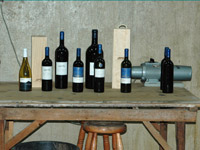 |
| Slow season at Aquitania - the label guy gets a few days off. |
We spent a few days in the Chilean capital of Santiago - a modern, clean city very close to the mountains. Our ride in from the coast was a breeze and we quickly found a hotel to spend a few days in. Visiting vineyards was on the top of our "to-do" list, so after a quick walk to check out the area, we took a day tour to visit a few. Our first stop was at a small “boutique” vineyard. Vina Aquitania produces only 200,000 litres of wine annually and almost all of their wine is bought by private buyers or select resellers. Even the labels were all placed on the bottles by hand. Although we are still fairly new to the finer points of wine, we thought their hooch was top-notch. We then went to a restaurant that served some great pork short-ribs and of course, some good wines. We actually had the pleasure of sharing a table and a bottle with two young Irish army officers who were with our tour. They had just spent the last six months doing peacekeeping duties with the United Nations in Africa and were spending six weeks touring South America for pleasure. Andy and Donal, although staunch Guinness connoisseurs, seemed to be having a good time learning about wine for a change. The afternoon was spent at another winery, Unduraga. This operation was just the opposite of Vina Aquitania, as Unduraga pumps out 15 million litres of wine a year. Not to say that their product isn’t good, it is - it’s just that when you see 10,000 litres of wine in stainless steel vats, two stories high, well it kind of takes the romance out of the product. Our guide informed us that 95% of all wine produced in Chile is exported. Only 3% is consumed by Chileans and the other two percent is consumed by tourists visiting the country. A fun day all in all and we learned a lot.
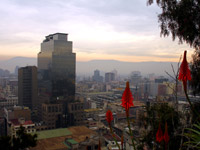 |
| Looking down on the city and east to the mountains. |
Downtown Santiago offers a subway system, again, very clean and efficient. There were also tons of busses but we relied on a taxi to take us to the Santiago ’s Teatro Municipal (city theatre) where we watched a young adult orchestra visiting from Italy. They were great - and the theatre, built around 1857, was beautifully done with angels holding up the tiered balconies, red crushed velvet chairs and a huge chandelier hanging from the ceiling. Sitting in the audience enjoying the music that night was definitely one of those “how lucky are we!” moments.
After a few weeks in Chile something else occurred to us. We were now riding more miles per day and taking less time to see the sights of Chile. The reasons behind this were several. The stroll had taken its toll, winter was closing in on us and we were still several thousand miles from Ushuaia, the southernmost town in the world and our ultimate goal. Riding south of Santiago, we were forced to add more layers of riding clothes for warmth and the farther south we went the rainier it became. Now riding has become a different type of endurance. In the deserts of northern Chile and Peru it was blowing sand and endless miles of rather drab scenery. In Central America it was the narrow ribbon of road with blind curves and stray animals. Now the challenge has become fog combined with soaking rain. Using our waterproof(?) gloves as windshield wipers and trying not to steam up our glasses when stopping in traffic has added to our riding experience. The landscape is green and hilly, much like Virginia or Pennsylvania, but we can see little of it. We pull into small hotels looking for covered parking (we at least want to start out as dry as possible) and a close-by restaurant. We peel off the layers, take hot showers, dress in dry clothes, eat hot food and then hit the sack. After most days of riding, we were able to dry all of our gear overnight by placing items on the radiator in our room (flash back to winters growing up in South Dakota) and onetime by using the gas space heater in the hotels restaurant. Lynne also used the same space heater as a cooking utensil when she stuck a piece of bread on a knife and toasted it to perfection. As we approach 40 degrees south longitude we can see that most of the Andes are above snow level. We had decided a bit further north to postpone crossing the Andes in hopes of avoiding some of the worst snow, and hope our gamble pays off. We will know in a few days.
When a town was big enough we would venture out (borrowing hotel umbrellas) and check out the local scenes. In one of the towns we stopped in, Los Angeles, we had purchased some items that we wanted to send back to the states. To tell the truth, I am always reluctant to buy items that we can’t carry with us on the bikes. Sending packages, like many of the simple tasks I take for granted back in the states, is a project usually requiring a day in itself. First you must find a shipping company or a post office. DHL and Fed-Ex were getting more and more expensive as we got further south, so post offices were the most economical way to ship. After first finding a local post office, you had to ask if this certain post office would send packages heavier than a pound - not all do. If they did not, then getting directions and the schedule for an office that did was the next hurdle. Then a few questions - did they require your package be wrapped in plain brown paper? If so, you must find brown wrapping paper - which was never sold at the post offices. Can we use packing tape? (need to find and buy) or must glue be used? This was true in Panama where I became very dubious that a package travelling thousands of miles, across several borders, in high humidity and sealed only with Elmer’s Glue-All would arrive in Pennsylvania with any kind of paper left on it. Did we remember to bring scissors and your passport? And did we leave our box open so they could inspect it? Let me tell you what fun it has been in other countries that not only wanted to touch and fondle each item but also ask you to list every item and the price you paid for it. In Peru , the FedEx guy even wanted a receipt for every item. Didn't happen. So when we found a Chilean post office that supplied everything - the boxes and packing tape and labels - we were thrilled! PLUS they securely taped the package and didn’t ask us to unwrap every last little piece of chutzpah. Only problem with that is, as of one month later – the box hasn’t arrived.
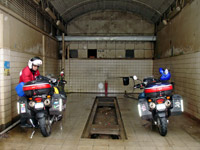 |
| Not the Ritz-Carlton, but it put a roof over our heads while trying to outlast the downpour. |
Osorno was our last stop in Chile and we enjoyed walking around the town eating freshly roasted peanuts coated with toffee and popping in and out of art galleries. Once again on departure day we awoke to rain - but it did abate long enough for us to pack our bikes. No sooner had we gotten on the road when the clouds opened up with a deluge. We hung out at a car wash (how ironic) located just outside of Osorno, hoping the downpour would end, which it did not, and we just accepted the day for what it was. The temperature dropped as we headed into the mountains and by the time we hit the Chilean border it was in the mid 40’s. No problems getting the exit paperwork and we took off for the Argentinean border post - located about 28 miles down the road. Crossing over the Cardenal Samore Pass became a little tricky when rain turned to sleet and staying out of slush on the road became a necessity. At 4,300 feet the temp was close to freezing and wiping the fog on the inside of the face shield brought a face full of snow. We were quite happy to see the blue and white flag of Argentina a few miles later!
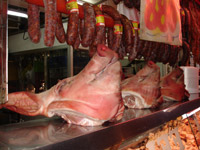 |
| Exploring some customs is more tantalizing than others. Pigs head for dinner, anyone? |
On a reflective note…after putting 17,000 bike miles under our butts, we have become immune to most of the idiosyncrasies of foreign moto travel - gas station attendants not wanting to give up their gas nozzles (we would rather be the ones to slop gas down the side of our bikes), thin-skinned to the constant gawking (we seem to be the travelling freak show) and automatons when it comes to checking into a hotel (“Do you offer a discount for cash and, more importantly, have parking for the bikes?”). However, even given all of this, the biggest constant is that we are still enjoying the trip. The ever-changing scenery is great - and exploring new towns and getting to know the people and their customs is the real boon. It’s true a long trip is a marathon and not a sprint, but if you can look past the day-to-day chores of packing and unpacking the bikes, finding a place to eat and sleep, plus the day-after-day numbing of a certain lower-body part, it is a remarkably rewarding experience that is constantly and slowly unfolding. Now if it would only stop raining…
Thoughts from Lynne
You know, Tom talks about taking less time to enjoy the sites - and that goes for taking pictures as well. I find myself taking the camera out less and less - sort of like how new parents take thousands of pictures of the first-born, but by the time the fifth child comes around, you're hard-pressed to find more than a few. I find it hard to believe that we have become jaded to the awesome spectacles we see everyday, but sadly, I guess that is true. Our senses have simply become overloaded with new sights, sounds and smells and processing them daily has unfortunately become ordinary.
However, still enjoying the trip????? Yep! Don't get me wrong - there are plenty of times that I question what the heck I'm doing - and Tom has to bouy me back up again. But there is still lots of laughter as well....
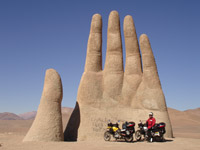 |
| When really cool things in the desert turn into.... |
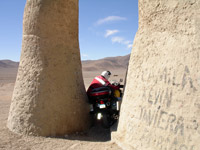 |
| A rock and a hard place. |
We're out in the desert in northern Chile and ride up to this enormous hand monument in the middle of nowhere. We take a few photos and are ready to leave. For some reason Tom decides to head out between the thumb and the pointer finger and promptly wedges his bike in between the two! Can't move forward - can't move backward. And me.... being the ever-helpful wife.... I'm standing behind him laughing my ass off and taking pictures. OK - there might have been a little more amusement in this one for me than for Tom, but you get the picture.

Copyright © 2005 All content and photography are the property of Tom and Lynne Gefre.
Contact us if interested in publishing or reusing any material.